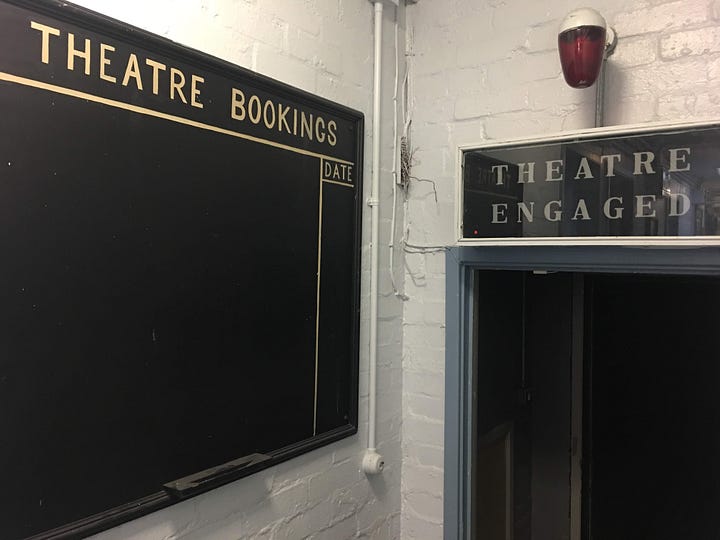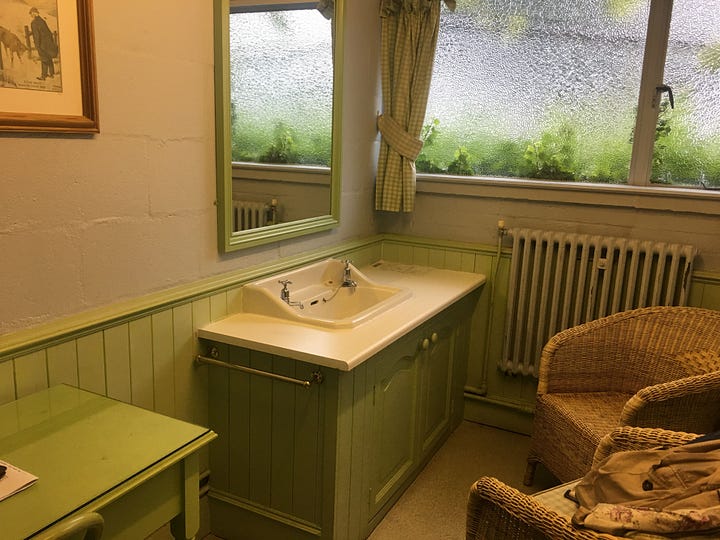I stood in the room where the first BBC television programme was broadcast in 1936!
My trip to the BBC studios at Alexandra Palace
Back in 2018 I was working on Tracey Breaks the News, a topical offshoot of Tracey Ullman’s Show. Some of it was filmed at Halliford Studios, a tiny little TV studio near Shepperton which hadn’t changed much since it was built in 1955, the same year Independent Television was launched in the UK.
While I was waiting around (filming involves lots of waiting around, ask anyone even vaguely connected to the industry) one of the security guards told me that we were the last show to film there and the day after we were due to wrap, bulldozers were going to raze the whole building to the ground.
So on my lunch break, I crept around the studios and took some photos of one of their last operational days. There was a real sense of stepping back into a previous era of television history. Chalk boards were hung outside studios to mark up what projects were booked to record there. Old sets and props were stacked up around every corner. It was absolutely glorious.




I posted these photos online thinking ‘people are going to find these so interesting’. So I was surprised when no-one interacted with the post in any way. Like, nothing.
I’m an actor and writer so I like to think I’m good at listening to feedback. I took this feedback onboard- (you know, maybe other people don’t find this stuff as interesting as I do 🤷♀️) - ignored it completely and I’m now beaming that same love of television history directly into your inboxes.
Because, I do love television. Not just the TV shows which I was glued to throughout my childhood, but the making of television and the whole history of broadcasting. It just enchants me. I remember getting a VHS tape of bloopers from one of my favourite TV shows, Bottom. It was called Bottom: Fluff. I’m sure many of you remember it. My teenage self found it impossibly exciting getting a glimpse of how a studio sitcom was actually made. The script supervisor popping onto the set with their ring binder and headset. Sometimes hearing the floor manager talking to the gallery. Just so bloody COOL. ‘Maybe one day I’ll be on a set like that and talking to a script supervisor’, I thought to myself. (Multi-camera sitcoms would mostly be out-of-favour by the time this became a possibility for me, although I have been lucky enough to do a couple.)
Television and radio have a special place in my heart which just can’t be supplanted by cinema or the theatre. There’s pomp and ceremony involved in going to the cinema or theatre. Dressing up and going out and sitting in the dark surrounded by strangers. It’s a spine-tingling atmosphere and I love both artforms dearly, but there’s something wonderfully domestic and familiar about the fact that TV and radio broadcasting comes to you. It arrives in your living room. In your office. In your bedroom. It doesn’t care who you are or what you look like; it lets itself into your home ready to inform, educate and entertain you. While movie stars feel distant and unknowable, telly stars feel like friends.
You get the idea. I love television. So when an opportunity came up to tour the old BBC studios at Alexandra Palace, I signed myself up immediately.
You could say the studios at Alexandra Palace are where TV began. 14 years after the BBC had started broadcasting radio, the ‘Television Committee’ was set up by the British Government. The committee recommended that a high television definition service should be established and run by the BBC. (At the time ‘high definition’ meant a picture made up of 240 lines or more.) And they opened it up to industry to see who could help them achieve that.
The BBC received several credible offers to run a television service: including one from the Baird Company offering a 240-line mechanical system, and another from Marconi-EMI offering a 405-line electronic system. The Television Committee was unable to choose between these two systems and so accepted both, there would be an experimental period where they would transmit the Baird system one week, and Marconi-EMI the next. The competition was on.
The first night of television programming happened on 2nd November 1936, there was just one show, a variety show, and it would be broadcast twice; once using Marconi EMI’s electronic TV system and once using the Baird Company’s mechanical system.
Which system went first was decided by a coin toss. The Baird Company won so mechanical television went first. Then, later that same night, those very few people with television sets who lived within a thirty mile radius of the Alexandra Palace transmitter were invited to turn a dial on their set from Baird to Marconi and watch the same variety show again but this time with Marconi EMI’s electronic TV system.
Readers, I stood in the actual rooms where those broadcasts happened! Marconi EMI’s studio became known as Studio A.




While the Baid Company’s studio was studio B.


I had to pinch myself that I was standing in the actual rooms where these formative moments in TV history took place.
Spoiler alert: Marconi EMI won the competition. To be honest, there wasn’t much competition to speak of. Marconi’s Emitron cameras produced clearer images, were movable while the Baird cameras had to be stationary and Marconi was 100% live while the Baird system required a 54 second delay for the image to be processed.
The rooms are no longer in use and are now derelict. After years of recording everything from Quatermass to Muffin the Mule, experimenting with colour television and launching BBC2, the BBC moved most of its programming out of Alexandra Palace to other studios including Television Centre, completed in June 1960. The Open University continued using the Alexandra Palace studios, until it too moved to its current base in Milton Keynes in 1980. Since then, the studios have fallen into disrepair.
The tour I went on was part of the London Festival of Architecture. When we were in Studio B, the room from where that very first variety programme had been broadcast, one of the LFA organisers asked us to write down what we thought should happen to those dilapidated studios. We wrote our thoughts on little transparent notes and stuck them to a blueprint of the building. When I was there, almost everyone wrote that such important rooms in the history of television should be the home of a museum. Some added that students studying television production could use the rooms where it all began.




This is all pure wishful thinking, of course. It would take an angel investor to make it actually happen. If you’re reading this, and you just don’t know what to do with the millions you have sitting in Coutts, drop Ally Pally a line here. (And remember to drop me a million or two as a thank you for putting you in touch with such a very worthwhile cause, as well. It’s only polite.)
John Logie Baird had been giving public demonstrations of televised images in various places in London, Glasgow, New York and Germany since 1925 but it was in those rooms in Alexandra Palace on 2nd November 1936 that a broadcast television service began. That feels important, right? That feels like something worth preserving and celebrating. Especially given the enormous influence television has had on our cultural lives in the last 90 years. It began there.
In 2013 Television Centre closed and over the next few years Studios 4, 5, 6, 7 and 8 were all demolished. Studios 1, 2 and 3 remain, but a sizeable part of Television Centre is now luxury flats.
This one was a steal at £1.2 million. (One can only imagine the service charge…)
I know it’s only a building. But this is where Morecambe and Wise, Sykes, The Two Ronnies, Absolutely Fabulous, Monty Python's Flying Circus, Keeping Up Appearances, Are You Being Served?, Open All Hours, Porridge, Fawlty Towers, The Fall and Rise of Reginald Perrin, Not the Nine O'Clock News, Hi-de-Hi!, Miranda and Alas Smith & Jones were recorded. AND THAT’S JUST STUDIO 8. There should be no room for luxury flats at TV Centre because it should be heaving with blue plaques.
I remember a programme on the BBC when I was a teenager which put out a call for all the wiped episodes from their archive. It was my first introduction to the notion that the BBC routinely wiped their tapes and consequently we’re missing episodes of Quatermass, Dad’s Army, Doctor Who, Hancock’s Half Hour, Out of the Unknown and almost all of A for Andromeda. I found it almost painful to watch. I understood that TV tape was expensive but this was television! Television is important! How could they not have seen that those shows were important?
I wish I could say that in the intervening years I’ve grown wiser and more stoical. But when I was looking around those dilapidated rooms at Alexandra Palace, I had that same feeling. This is television! Television is important! And it started here. How can they not see that these rooms are important?





Absolutely loved this, Gemma! Hoping one day I get to be in a TV Studio. At 48, I've still got plenty of time to get going!